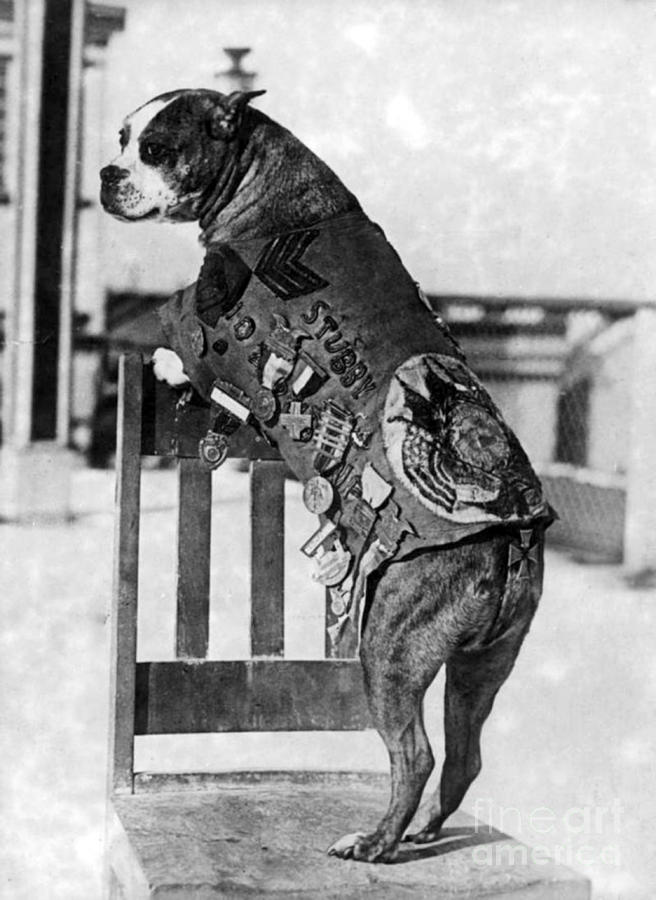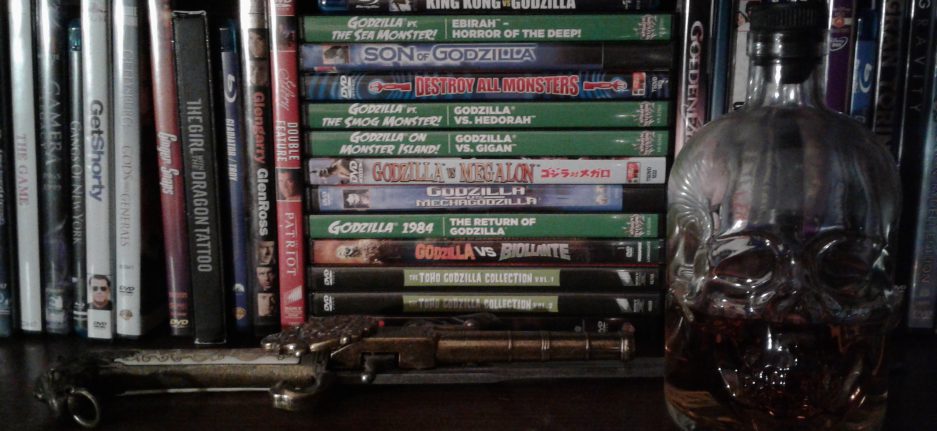Warning: Cute doggo pictures inbound.
It took a few years, but the United States entered World War I in 1917 on the side of the Allied Powers. A draft ensued. In New Haven, Connecticut, on the grounds of Yale University, the 102nd Infantry Regiment (1st Battalion (Only Battalion, technically)) of the Connecticut National Guard trained for impending battle. As they did, a stray mutt wandered into camp, hanging around the soldiers and eventually becoming close to one Robert Conroy. The mutt’s ancestry is a touch hazy, but he looked to be some sort of pitbull/Boston terrier/bull terrier mixture. Due to his little nub of a tail, he was dubbed Stubby, and he quickly became the regiment’s unofficial mascot. When it came time for the regiment to ship off to France, Conroy smuggled the dog onto the ship; he was allowed to stay when he adorably saluted the commanding officer, a trick Stubby was taught during training.

In the trenches, Stubby quickly made himself useful by detecting enemy bombardments before any humans could (dogs have some pretty decent hearing, I hear), locating buried soldiers, found wounded men on the hazy battlefield, and warned the men of impending gas attacks. In order to protect the little guy, he was fashioned his own miniature gas mask.

During his eighteen months of battle, Stubby was twice wounded by grenades, but he kept right on coming back. When he single-pawedly caught a German spy during the Meuse-Argonne Offensive, Stubby was recommended for an honorary rank of sergeant, though whether or not he was actually given the honor remains up in the air — regardless, he was thereafter referred to as “Sgt. Stubby”. He was given a handmade chamois coat by the women of Château-Thierry, a reward for his courage and service toward the town during its liberation. Many medals were accrued by the little guy.

Following a fairly illustrious career (especially for a dog), including a potential meeting with a young George S. Patton (I can’t say for sure, but they were both in the area of Saint-Mihiel around the same time, so it’s possible), Stubby was smuggled back home with Conroy after the armistice. The little guy was hailed as a hero, the subject and leader of parades and celebrations. He even got a medal from the Humane Education Society awarded to him by Blackjack Pershing hisself.

The little guy stayed with Conroy as he entered Georgetown’s Law School, eventually becoming the Hoyas’ mascot (take that, usual bulldog!). He would live out the rest of his days in peace, happiness, and fame, until passing in his sleep in 1926. He received all sorts of posthumous tributes, including an eventual Purple Heart (the medal didn’t yet exist when he was serving), among several other medals and honors. Today, his preserved skin is on display at the Smithsonian’s National Museum of American History, his exploits living on in the hearts of those who hear his tale.

I s’pose it was only a matter of time before his story was told on film, and, wouldn’t ya know it, it’s an animated picture.

An international endeavor from Mikros Image and endorsed by the US WWI Centennial Commission, Sgt. Stubby: An American Hero relates the above story, albeit toned down a touch for younger audiences. Fear not, Stubby doesn’t speak in the film, he stays the normal barking, growling, whining canine. Stubby’s life from his stray days in New Haven through his battlefield exploits is shown, along with his relationship with Conroy. Conroy’s friendship with a French soldier is also chronicled.
The animation is nothing to write home about, with a distinctly cartoonish style, fluid movements, and a fairly bright color palette. The script leans heavily in favor of a younger audience, relatively simple lines and plots throughout. The voice actors do well enough, with Gerard Depardieu (portraying Conroy’s French compatriot Gaston Baptiste) leading the way with a pretty great performance; Helena Bonham Carter’s American narrator (Conroy’s older sister, never seen) is fine, though I wonder why she in particular was chosen; and Logan Lerman’s Conroy is on the weaker end of things, coming across about as bland and generic as his character’s design. The Great War as shown in this film isn’t quite as bloody, dark, and bombastic as one would expect, though the target demographic being what it is, this isn’t all that surprising. Possibly the worst part of this simplistic approach, aside from the astonishing amount of quiet and down time, is the Germans’ portrayal, consisting of dark, German-speaking spectres who almost always bear their gas masks, even when standing about and cooking sausages. Only one German soldier is given a face, the spy Stubby catches, and it seems for a moment as though we’re going to get some semblance of recognition of the enemy’s humanity, but it’s quickly swept away as we trot along to the next plot point. I know this makes the conflict easier to conceptualize, but it reeks of that peculiar strain of blind patriotism that forgets the fault of its own country and emphasizes those of past foes.
All that aside, the film is quite effective at communicating Stubby’s heroism and the bond he shared with Conroy and the rest of the unit. You feel a direct connection with this CGI dog, as he plays, bemoans Conroy’s absences, gets wounded, and maintains the troops’ elan. Moreover, we feel the friendship between Conroy and Baptiste, the camaraderie between Conroy and his fellow New England recruits (including a German immigrant, a nice touch, honestly, especially with the whole “faceless enemy” thing going on), and their struggles in a dangerous land. The simplicity of the story and the animation help here, honing our attention on the emotions and courage on display before us. I remember getting misty at several occasions, bordering on waitnoI’mnotcryingyou’recryingshutup but not quite making it all the way. Frankly, this is quite the achievement for an animated film like this (allegedly the first CGI film to tackle a true life subject, though I’d argue at least the theme/story of Valiant deserves the recognition there, though here we have a direct historical narrative, so…), and the filmmakers deserve plenty of praise for bringing Stubby’s story to life in such a vivid and entertaining way. I do wish they’d have shown his post-war years, that he led a happy life after months of battle; as it stands, the ending is slightly abrupt, but it’s not the biggest deal.
I may have had some low expectations going in, considering I’d never heard of the film and I’d only seen some rudimentary-looking stills, but I was greatly and pleasantly surprised by what hit my eyes. I highly recommend the film for any interested in the story, especially the younger folks (trust me, this thing is safe for nearly all ages). It’s a fun time, and that dog is just so damned cute! I proclaim this officially the most adorable war film ever made, and I wonder if that title will ever be usurped.
One more salute for the ol’ four-legged hero!

